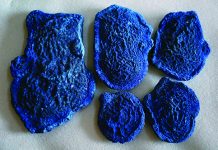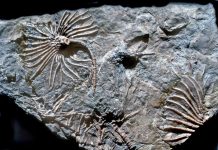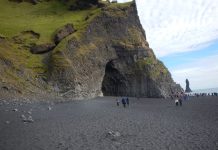
By Bob Rush
In early June, my wife Pat and I attended the second annual Monterey Bay Jade Festival, which was held at the Custom House Plaza in the Monterey State Historic Park, Monterey, California. The plaza is an open area with views of Fisherman’s Wharf and boats tied to the dock. The dealers’ booths were arranged within the plaza and old mission-era buildings surrounded the space.
It was an ideal location to celebrate jade in all of its splendor.
The idea for hosting a show in this location came out of Mother Nature’s vagarious acts 65 miles further south. The Big Sur Jade Festival on the coast below Gorda, California, has been held every October, for more than 25 years.
Working With Nature
It is a very popular show that specializes in the local jade that was found underwater and in local hillsides. Unfortunately, in 2016 a local forest fire caused the festival to be canceled. The next year, flooding further north washed out a bridge on Highway 1, the only road traversing the coast and the main access to the festival. The final blow was a massive mud slide in 2018 that destroyed a significant part of the same highway. This slide was so massive that it created an additional six acres of new coastline. It took many months for crews to build a path for the coast highway.
As a result of these events, members of the jade collecting community decided to develop another jade festival, in a different location, as a complement to the original Big Sur Jade Festival. It was decided the new festival would be held at a different time of the year, to not conflict with the original show in October.
Georg Schmerholz, Rudy Estrada and Kenny Comello were the driving force behind establishing a jade festival in the Monterey location in June. The trio formed a non-profit organization so show proceeds could be donated to the adjacent State Historical Park, for upgrading facilities and exhibits.
The Monterey show featured 50 dealers, including some jade mine owners, who came from various places in North and South America.
Connecting With Fans of Jade
During the show, I met dealers Jesus and Anne Ruiz, owners of Bright Treasures. Their booth display included two small carvings, both of which won awards during one of China’s most prestigious jade carving exhibitions, Zi Gang Bei. The exhibition was held in Suzhou, China, and thousands of people attended. The competition has been open to jade carvers outside of China since 2014. In 2017, the couple traveled to Suzhou to enter the competition. As longtime carvers, they felt this would be a great opportunity to evaluate their carving skills. Jesus entered his frog carving made from Wyoming olive nephrite. It won a bronze medal. Anne entered her Möbius heart carving made from Yukon nephrite. It also won a bronze medal. Each award was commemorated with a plaque engraved in Chinese.
In 2018, they went back to the exhibition to enter a bowl carving done by Jesus. The bowl is made of nephrite from Yemen and features three Mayan images carved on the perimeter. While carving the bowl, Jesus had to utilize larger machining equipment to core drill the center and remove significant material from the interior.
He used a variety of tools including diamond burs, silicon carbide sticks, diamond paste, and felt wheels. In many situations, he’s had to create the tools needed to do the work. He has been carving jade for about 15 years. Also, he was a member of the Contra Costa Mineral and Gem Society for many years before joining the nearby Santa Clara Valley Gem and Mineral Society in 2004.
A Life Changed By Jade
Another very interesting dealer I encountered was Andrew Shaw. He was selling several items, including the book he published recently. It was my first book purchase of the show. I chatted with him about the book and his interest in jade and decided to read the book that evening and return the next day for more discussion.
Shaw is a former reporter for the British Broadcasting Company who needed a break from the stress of the job, so he traveled to Thailand in 2002 for a four-month sabbatical. During that sabbatical, he came across a small jade shop where he spied a lavender jade-carved Buddha. He became enthralled with the piece and the soft beauty of the jade sang to him, so he bought it on the spot, he said. Shaw fell in love with jade at that moment and carving jade became his new passion or possibly even an obsession.
After the sabbatical ended, he returned home and contemplated a future that would encompass an involvement with jade. He started reading about jade but found that most of the books were about ancient jade, which was not exactly the focus of his interest. He was much more interested in modern quality carvings and felt that he must go to the source of these carvings – China. It helped that he also had the urge to carve his own.
Finding Happiness In Jade
Fast forward to 2006. Shaw was reevaluating his life, following the death of his mother, and concluded that he would be happier carving jade. He got his life in order and chose to go to Suzhou, China. From this point on, learning about jade carving became a series of hurdles. When he arrived in China his first hurdle was explaining to immigration officials why a former BBC reporter wanted to go to Suzhou.
By taking a job teaching English, he was able to get his visa. Concurrently, he enrolled in a local university to learn Chinese.
The next and most exasperating hurdle was finding someone to teach him how to carve jade. Seven months later, he came upon a tiny little carving workshop among the multitude of shops. It took another year and multiple conversations to ingratiate his way into being a student of jade carving. Most people he met dismissed him because the typical Chinese carver stops at age 50 and Shaw was 52 at that time. Finally, he found a carver who was willing to let him use a carving spindle in his workshop. He went there every afternoon for two years.
After learning the basic skills of carving, Shaw set up his workshop where he works weekdays, and on weekends he sells his pieces at a local market. He is believed to be one of the only foreigners to have learned to carve jade in China. Over the years, he became so highly skilled that in 2013 he too entered the Zi Gang Bey jade carving competition, and, to many people’s surprise, won a medal.
His book, Jade Life: An Englishman’s Love Affair with China’s National Treasure, was published in 2019 by Earnshaw Books. It details not only his story but significant information about the industry in China. It can be found on Amazon.com.
Dealing In Jade
Throughout the show, I found discussions with the jade mine owners to be very educational and enlightening. One of those owners was Roger Krichbaum, who discovered and filed a claim in 1979 on the Yukon jade site. His nephrite jade mine is perched high atop a rugged mountain in Canada’s Yukon Territory. Located at such a high latitude and altitude means that the jade is not easily accessible most of the year. Normally, he’s only able to mine a couple of months a year. The rest of the year is spent preparing the large jade blocks for sale and going to various shows to present the product in the best manner possible.
Krichbaum specializes in working with jade-carving and sculpture-making artists who need a special stone to create the art of their dreams. He has many jade blocks of different sizes, shapes, and colors that will align with the various artists’ visions. Several examples of finished art pieces, with more to come, featuring Krichbaum’s jade pieces can be seen at his website, www.yukonjade.com.
While I was chatting with Krichbaum, I noticed an unusual and striking pattern within a block of jade on one of his tables. It caught my eye rather quickly and when I lifted it, I was startled by its weight. Even though I knew nephrite was quite dense and thus could be heavy, I hadn’t expected it to be that heavy. I asked Krichbaum how much it weighed, and he said 10 pounds! I put it back down and continued to visit with other dealers. As I wandered about that hefty piece of jade kept popping into my mind. Shortly after, I made my way back to Krichbaum’s booth as I had to have that piece.
I asked him the price, and he said $50 a pound. Gulp! With some bargaining, I was able to make it mine. I asked Krichbaum if he would hold the piece while I took a photo. This event is one I will cherish for a long time.
Specializing in Nephrite Jade
For me, the most prominent dealer at the show was Kirk Makepeace. He is the owner of the company Jade West, one of the world’s largest producers and exporters of nephrite jade. The company operates four mines in Northern British Columbia, about 100 miles east of the Alaskan border. Makepeace bought his first mining claim in 1971 and continued onward, eventually purchasing three more mines. Today he controls much of the world’s nephrite market and annually mines as much as 500 tons, which primarily is for the Chinese jade market.
The four mines under Jade West ownership and operation include Kucho, the largest producer, the Ogden Mountain, the King Mountain, and the Polar. Many feel that the Polar jade material is the best quality of all the mines. Due to the locations of the mines, the mining season is very limited, usually only a couple of months in the summer. During the winter months, many millions of dollars of winterized equipment sit at the mine sites and survive the very harsh northern climate.
At the end of the very short mining season, a nearly frantic swarm of buyers arrive at the Jade West fields and climb over large boulders of jade, marking the piece they want. As mentioned earlier, many buyers prefer the Polar material due to its superior hardness, deep green color, and translucency. Due to the rapid expansion of the current Chinese jade carving industry, the price for jade has significantly increased. This is supported by research conducted by Shaw in writing his book, which reveals at present there are at least 1 million Chinese jade carvers.
Digging Into Jade Mining
Exploring the jade mining process is a fascinating review. The operation includes four distinct steps. First, is the exploration, where miners drill into the mountainside with water-cooled and diamond-tipped core drills. The cores are extracted and examined to confirm that the material meets the high-quality standards of the company. With such a short mining season, it is critical to focus on only the best material.
The second step is to examine the face of the material for any cleavage points. Because nephrite jade is so strong and difficult to separate, mine workers must seek out any weak points when beginning to separate. Additional core drilling along these cleavage points allows the mining crews to use heavy hydraulic spreaders to push the jade apart. After the pieces are separated, crew members again use heavy machinery to pull them out.
Cutting the pieces into more manageable sizes is the third step in the process and involves using huge circular diamond saws with a lot of water to keep the process cool. The saws are also used to cut a window to expose the beauty contained within the boulders.
The final step involves transporting the boulders to the nearest settlement, Dease Lake, which is a full day’s drive. At the end of the mining season, all of the assembled boulders are trucked down to Jade West’s Vancouver warehouse.
Community Driven By Connections
Though I didn’t have much time to talk to Kirk Makepeace at the show, he was very gracious and willing to share his knowledge about business and the jade-carving industry. At the Jade West website, www.jademine.com, you’ll find information about the mining process, finished products made from Jade West material, and pieces of rough for sale.
As I made my way around the show, booth by booth, I spied a third edition copy of the renowned Fred Ward Gem Series reference, Jade. I have the first edition, but not this revised edition, so I figured it was time to update my knowledge about jade from one of the most informative books around. Also, I spotted a couple of samples of raw amber mined in Chiapas, Mexico.
From the exterior, there was no indication of what was inside either piece offered by a dealer. The pieces had a similar shape and size, but the outer surfaces differed. Yet, when the dealer shined ultraviolet light on a chipped area on each specimen, they fluoresced a shade of blue. The dealer also had a phenomenal necklace made of 13-mm beads of the featured amber and Guatemalan jadeite. While it was very impressive, it was probably quite expensive, so I didn’t dare ask the price.
Inspired by Jade
Another inspiring dealer is the co-organizer of the show, Georg Schmerholz, a multi-talented, award-winning jade carver. He shared a booth with co-organizer Rudy Estrada, where he displayed fantastic carvings. The first thing I encountered at the booth was a smiling Schmerholz with a copy of his book, Jade: a sculptural medium.
I quickly acquired a copy, my third book purchase during the show. I was torn between flipping through the pages of the book or devouring the beauty of his phenomenal jade carvings that were spaced around the display tables. The carvings took precedence! One carving was a baby’s face carved in Siberian nephrite and encased by a carved wood surrounding. The piece had won a gold award during the 2014 Zi Gang Bei annual jade competition.
As I walked around this booth, I kept encountering one fabulous carving after another. Everything was amazing in its perfection, creativity, and soul-searching aura. As I gazed into the depths of each item, my mind wandered away from the present hustle and bustle of the show to what was transpiring in the mind of the creator during the creative process. I came out of my trance as our 8-year-old granddaughter’s voice beckoned me to hurry up. We had promised her she could go swimming that afternoon in the motel’s pool.
That evening I had the opportunity to read Schmerholz book, both the “front” section and the “back” section. It is organized in an unusual manner where the front half of the book transitions through his life as a carver of jade, with descriptions of each piece illustrated in professional photographs. The back of the book is accessed by flipping it over where the new “front” of the book is a picture of a soaring eagle cast in bronze.
Embracing Inspiration Of Jade Experts
The back section tells more about Schmerholz’ evolution as a jade carver that includes realizing at an early age that, contrary to his parents’ wishes, he didn’t want to become a classical violinist. When he came of age, he left home to seek his way in life with a lingering urge to create with his hands.
One of the many pieces featured in Schmerholz’ book that held me in awe is his carving of “Baby Draco,” a torque, or solid neck ornament. It is made from nephrite mined from Makepeace’s Kutcho mine. Before he carved the piece, Schmerholz researched the subject of dragons to inspire his interpretation.
For further information on his work and photography visit his website, www.schmerholz.com.
There were many other outstanding jade artists and vendors at the show, but, unfortunately, I ran out of time before I could visit with more. I plan on attending next year’s show, slated to take place June 12-14, 2020, in the same location, the Custom House Plaza, Monterey State Historic Park in Monterey, California. For more information about the show, visit www.montereybayjadefestival.org.
However, we don’t have to wait until next year to enjoy a top-notch jade show. October 11-13 marks the 26th Annual Big Sur Jade Festival. Many of the same dealers who attended the Monterey event will be at this festival, which will be held at the Los Padres National Forest, across from Sand Dollar Beach, along Highway 1.
For more information, visit the event website, www.bigsurjadefestival.com.















